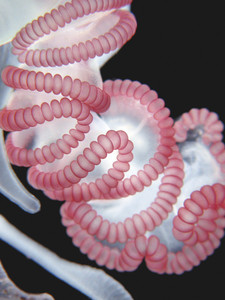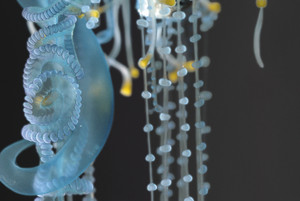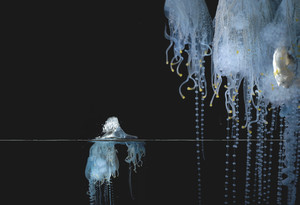
ALVARO E. MIGOTTO
Main tentacle rimmed by nematocyst bacteriaALVARO E. MIGOTTOMany people who went to celebrate New Year’s Eve 2008 on the coast in São Paulo’s had to leave the beach and find hospital emergency rooms to treat the welts caused by floating bubbles full of tentacles. Newspapers soon printed headlines about the invasion of jelly fish, which generated a nationwide wave of alarm. But specialists contested the news, saying that there had been no invasion and no jelly fish.
The inflated part, the floater, is the base of the colony, from where the zooid sprouts These creatures come in beautiful shapes of all kinds and the group resembles a Carnival float. The corkscrew-like zooid is the main tentacle. When it stretches, it can reach out to its prey – or swimmers – as far away as 20 meters . When seen close up, numerous egg-shaped beads lie on the edge of a pleated, almost transparent membrane that resembles the ruffles that embellished 16th century French aristocrats. Each of these beads houses hundreds to thousands of tiny poison capsules, called nematocysts. In greater numbers, the delicate tentacles that resemble strings of pearls form a curtain of nematocysts that immobilize and kill the fish swimming nearby, and which are then consumed by the gastrozooids, the curly strings with a yellow opening on the tip.
The reproduction agents are hidden in the midst of this huge crowd, in an agglomeration that looks like a cauliflower.
These colorful creatures sail through the seas, carried by the winds and sea currents. They sometimes form squadrons randomly and land on crowded beaches. Physician Vidal Haddad Junior is emphatic: there was no invasion. A professor at Paulista State University (Unesp) in Botucatu, he also works for the Butantan Institute, where he is in charge of treating casualties caused by sea animals. He explains that the number of Portuguese men-of-war increased only in some beaches in the State of São Paulo, such as Praia Grande and Mongaguá, which occurs normally, from time to time.

ALVARO E. MIGOTTO
Arsenals of beads and with yellow mouths: predators in the form of jewelsALVARO E. MIGOTTOIn Haddad’s opinion, this was a human problem and not a zoological one. Brought in by ocean currents, the squadrons of Portuguese men-of-war arrived at the crowded beaches where accidents were inevitable. Still, the number of casualties was low relative to the throngs on the beaches. The physician set up camp at Praia Grande beach, where he recorded 300 such incidents in the midst of one million beachgoers. “Now we know that 99% of them weren’t serious, as they only caused a mild skin rash,” says Haddad. The toxic effect of the nematocysts’ poison rarely has serious consequences, such as cardiac arrhythmia or respiratory arrest.
The wave of alarm was unjustified, but it had some effect. “We collected all the clinical exam forms on Praia Grande. This was the first time that the number of casualties was kept track of and documented in detail,” says Haddad, who is analyzing the data to publish it later. He hopes to standardize the medical response, in order to help regions where complaints of this kind are less frequent, such as Brazil’s Northeast.
Those who usually go to the beaches in Brazil’s Northeast are not astonished by the flotillas of Portuguese men of war, which are carried to the Atlantic’s southeast by the trade winds. Casualties in the Northeast are less common than in the Southeast, where the floating sea creatures appear sporadically. To understand why this happens, zoologists Juliana Bardi and Antonio Carlos Marques, from the University of São Paulo, studied examples from more than three thousand kilometers of seacoast, from the state of Ceará to São Paulo. They found no differences.

ALVARO E. MIGOTTO
Portuguese Man-of-War (left) uses its net of poisonous tentacles to capture fish (right)ALVARO E. MIGOTTOThe length and the number of the creatures’ tentacles, and the density and distribution of the nematocysts, are similar on any Brazilian beach. The disparity of the casualties has not been explained yet. The mystery does not end here. Until recently, nobody had investigated which of the two known species, Physalia physalis or P. utriculus, are found on our beaches. They are characterized by their corkscrew-shaped main tentacles. P. utriculus has only one such tentacle, whereas the P. physalis always has more. Marques and Juliana identified the Brazilian creatures as being P. physalis. The conclusions, as well as the detailed description of these creatures, were published in the December issue of the zoology journal Iheringia, from the State of Rio Grande do Sul. In addition to identifying the Brazilian species, Marques also questions the traditional classification. “When it is young, physalis can also have just one tentacle,” he explains. As it ages, the colony grows and more tentacles appear. Marques believes that the Portuguese man-of-war, traditionally recognized as being two species, is actually just one species at different stages of its life.
Never touch the Portuguese Men-of-War; even their floater contains poison. In extremely rare cases, these toxins can cause cardiac arrhythmia and respiratory arrest. In normal casualties, it is enough to apply seawater, ice or vinegar on the welts.
The Project
On the biodiversity, evolution, endemic nature and conservation of the Southeast Atlantic medusozoa; Type Thematic Project; Coordinator Antonio Carlos Marques – USP; Investment R$ 570,194.96